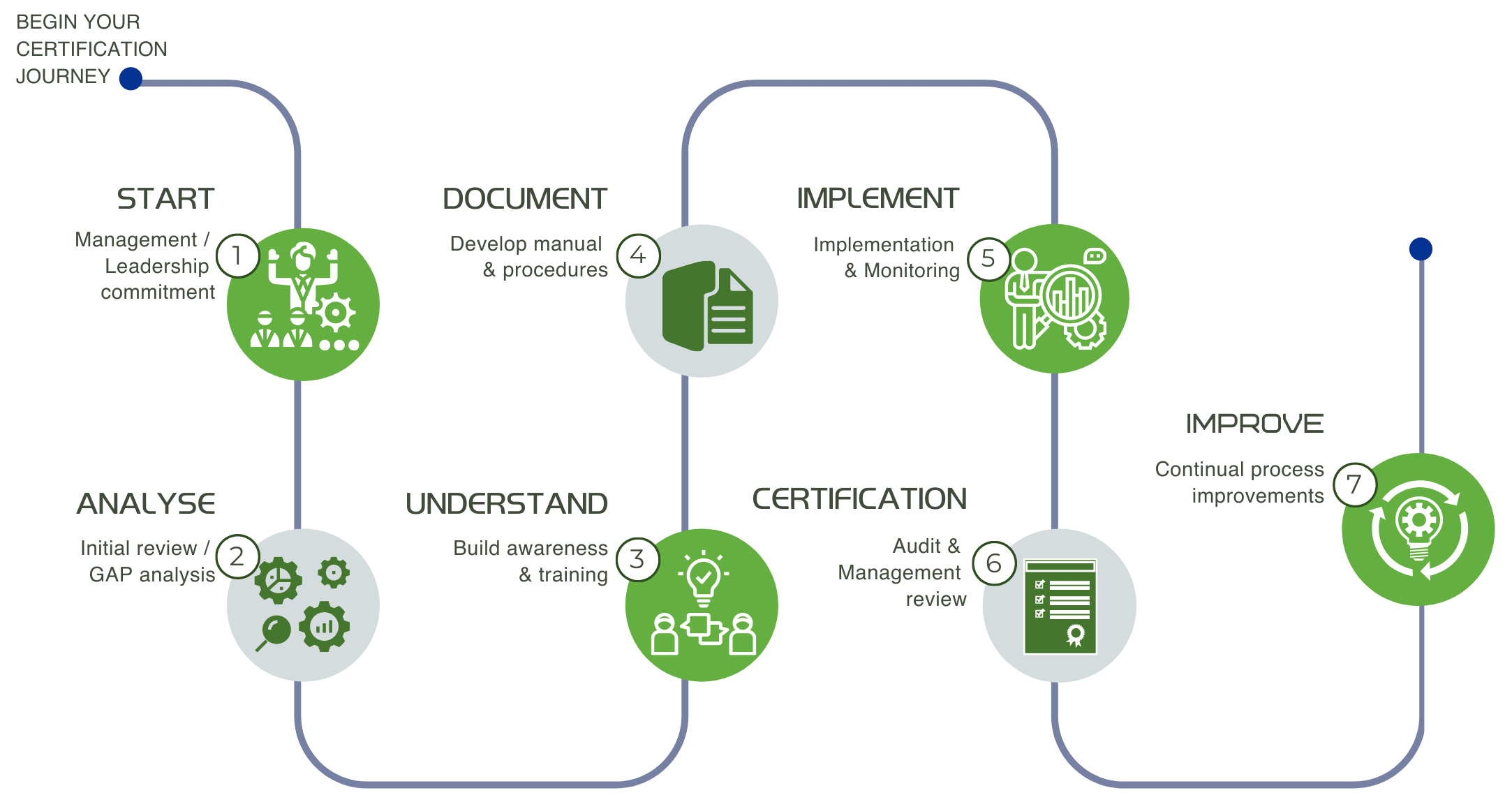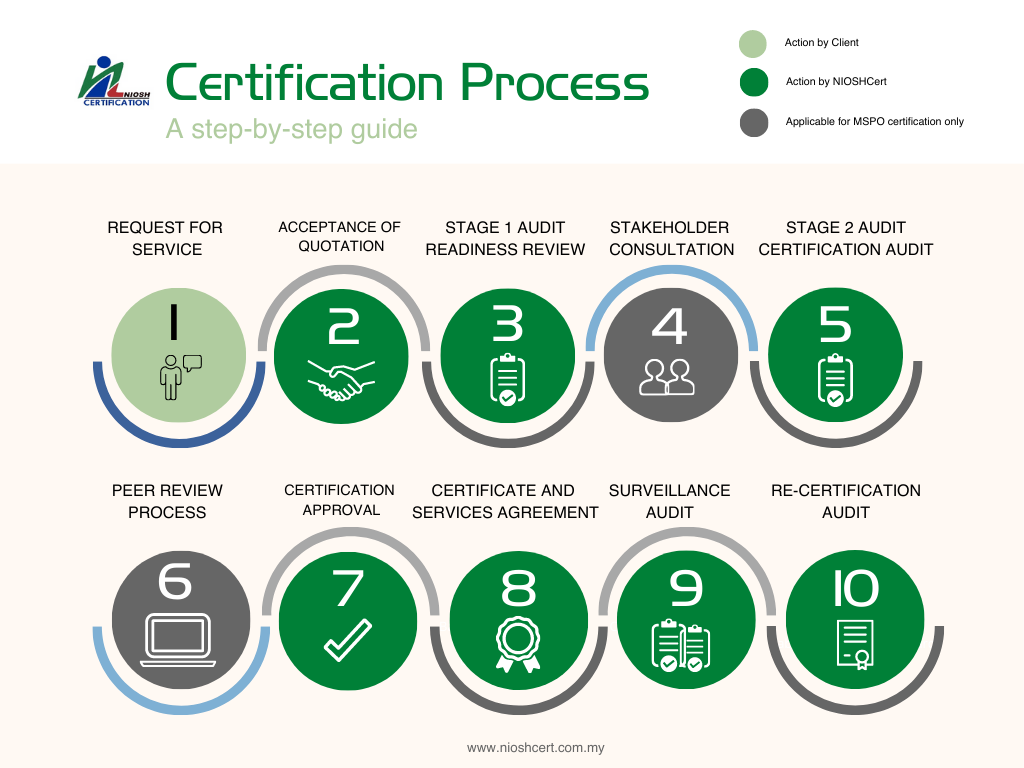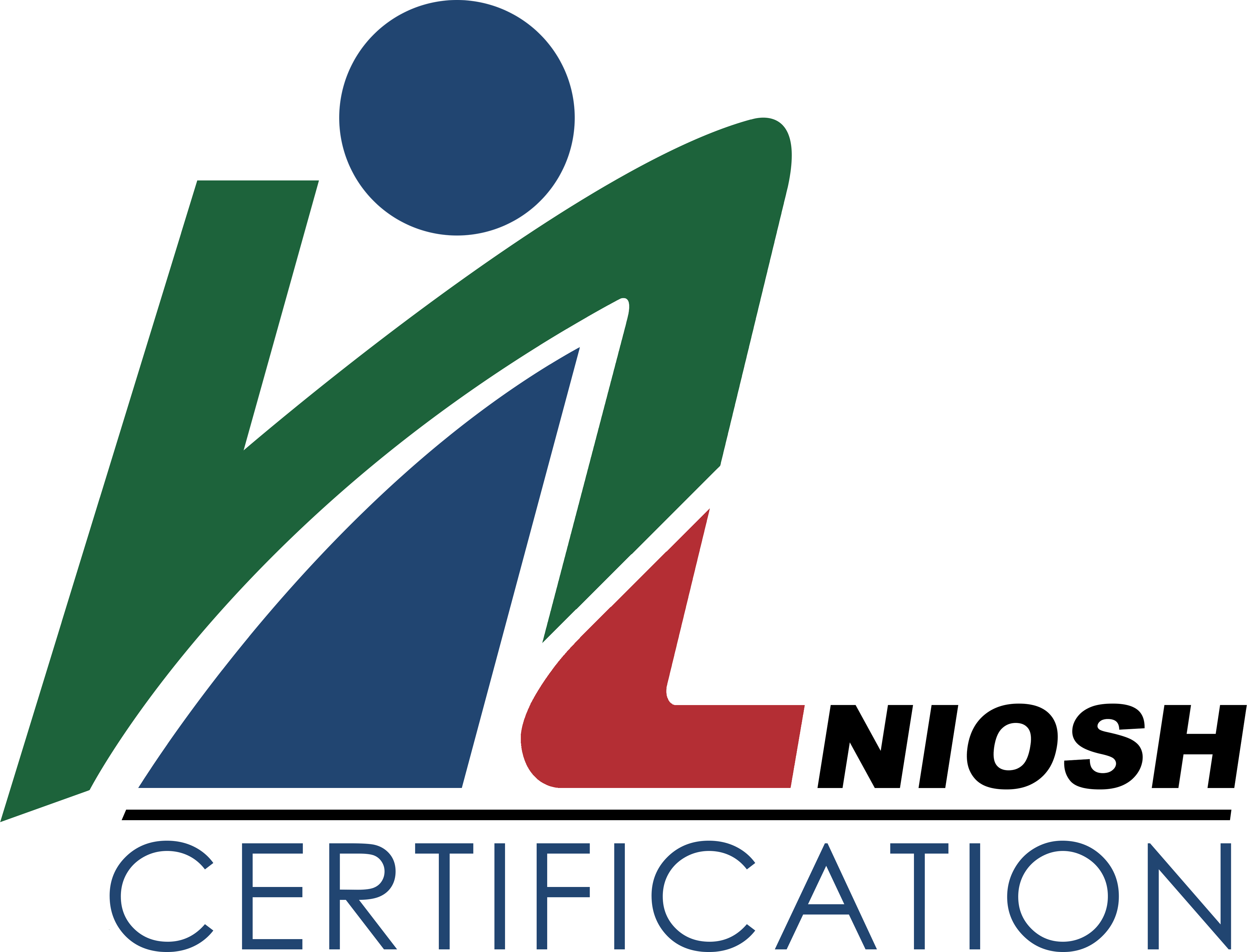Certification
Conformity Assessment
Having certification for internationally recognised standards inspire trust, increases credibility and provides a mark of confidence in a company’s performance, continuous improvement and operational efficiency.

What We Offer For You
Your key to achieving objectives, from quality to safety, health, and more, including specialized areas like adventure tourism and road safety.

Occupational Health and Safety
Management Systems
Contributes to SDGs:
Goal 5: Gender Equality
Goal 8: Decent Work and Economic Growth
Goal 9: Industry, Innovation and Infrastructure
Goal 10: Reduced Inequalities
Goal 11: Sustainable Cities & Communities
Goal 16: Peace, Justice & Strong Institutions

Quality
Management Systems
Contributes to SDGs:
Goal 9: Industry, Innovation and Infrastructure
Goal 12: Responsible Consumption and Production
Goal 14: Life Below Water

Environmental
Management Systems
Contributes to SDGs:
Goal 2: Zero Hunger
Goal 3: Good Health and Well-being
Goal 4: Quality Education
Goal 6: Clean Water and Sanitation
Goal 7: Affordable and Clean Energy
Goal 8: Decent Work and Economic Growth
Goal 9: Industry, Innovation and Infrastructure
Goal 12: Responsible Consumption and Production
Goal 13: Climate Change
Goal 14: Life Below Water
Goal 15: Life on Land

Road Traffic Safety
Management Systems
Contributes to SDGs:
Goal 11: Sustainable Cities & Communities
Goal 12: Responsible Consumption and Production

Food Safety
Management Systems
Contributes to SDGs:
Goal 5: Gender Equality
Goal 8: Decent Work and Economic Growth
Goal 9: Industry, Innovation and Infrastructure
Goal 10: Reduced Inequalities
Goal 11: Sustainable Cities & Communities
Goal 16: Peace, Justice & Strong Institutions

Adventure Tourism Safety
Management Systems
Contributes to SDGs:
Goal 10: Reduced Inequalities
Goal 11: Sustainable Cities & Communities
Goal 16: Peace, Justice & Strong Institutions

Anti-Bribery
Management Systems
Contributes to SDGs:
Goal 10: Reduced Inequalities
Goal 11: Sustainable Cities & Communities
Goal 16: Peace, Justice & Strong Institutions

Information Security
Management Systems
Contributes to SDGs:
SDG 9: Industry, Innovation, and Infrastructure
SDG 16: Peace, Justice, and Strong Institutions

Facility Management
Management Systems
Contributes to SDGs:
Goal 7: Affordable and Clean Energy
Goal 9: Industry, Innovation and Infrastructure
Goal 11: Sustainable Cities & Communities
Goal 12: Responsible Consumption and Production
Goal 13: Climate Action

Quality Management System
For Medical Device
Contributes to SDGs:
SDG 8: Decent Work and Economic Growth
SDG 9: Industry, Innovation, and Infrastructure
SDG 12: Responsible Consumption and Production
SDG 16: Peace, Justice, and Strong Institutions

Malaysian Sustainable Palm Oil
Contributes to SDGs:
Goal 12: Responsible Consumption and Production
Goal 13: Climate Change
Goal 15: Life on Land

Hazard Analysis
Critical Control Point
Contributes to SDGs:
Goal 12: Responsible Consumption and Production
Goal 13: Climate Change
Goal 15: Life on Land

Good Manufacturing Practice
Contributes to SDGs:
Goal 12: Responsible Consumption and Production
Goal 13: Climate Action
Goal 15: Life on Land:

International Sustainability and Carbon
Contributes to SDGs:
Goal 3: Good Health and Well-being
Goal 6: Clean Water and Sanitation
Goal 7: Affordable and Clean Energy
Goal 8: Decent Work and Economic Growth
Goal 9: Industry, Innovation, and Infrastructure
Goal 12: Responsible Consumption and Production
Goal 13: Climate Action
Goal 14: Life Below Water
Goal 15: Life on Land
Goal 17: Partnerships to Achieve the Goal
Client Guidelines for Management System Certification
1. CERTIFICATION PROCESS
Elaboration on the steps in the Certification Process:

3.1. Request for Service and Negotiation
- The client requests a quote by filling the NIOSHCert Application Form and Questionnaire.
- A Service Agreement is prepared, which includes a Summary of the Fees and contractual obligations of both NIOSHCert and the Client. The Certification cycle is three years barring any issues that may arise.
3.2. Acceptance of Quotation and Signing of Service Agreement
- Upon conclusion of negotiation, the Client signs both the Acceptance of Quotation and Service Agreement (Contract).
3.3. Stage 1 Audit: Readiness Review
- Stage 1 Audit usually takes place at the Client’s premises and aims to establish the status of the existing documentation in relation to the requirements of the certification standard/scheme. Some of the management processes may also be audited at this point.
- The objectives and purpose of the Stage 1 Audit are:
- To audit the client’s management system documentation and some management processes through an evaluation of the client’s location and site-specific conditions and to undertake discussions with the client’s personnel to determine the preparedness for the Stage 2 Audit. These can include:
- Reviewing the client’s status and understanding regarding requirements of the standard, in particular with respect to the identification of key performance or significant aspects, processes, objectives and operation of the management system;
- Collecting the necessary information regarding the scope of the management system, processes and any statutory regulations;
- Reviewing the allocation of resources for Stage 2 Audit and to agree with the Client on the details of the Stage 2 Audit;
- Evaluating the internal audits and management review are being planned and performed, and that the level of implementation of the management system substantiates that the client is ready for the stage 2 audit; and
- Verifying that all information previously provided by the Client is still accurate and relevant.
- Any further details, changes required, including the number of days for Stage 2 must be agreed, before the report is completed.
- To audit the client’s management system documentation and some management processes through an evaluation of the client’s location and site-specific conditions and to undertake discussions with the client’s personnel to determine the preparedness for the Stage 2 Audit. These can include:
3.4. Stakeholder Consultation* (Applicable to MSPO Certification)
NIOSH Certification undertakes an audit of the management unit and holds consultations with the relevant stakeholder groups to gauge the level of compliance against the requirements stipulated in the standard. Stakeholder groups can provide relevant information with regard to the organisation’s compliance with the environmental, social and economic requirements of the standard.
3.5. Stage 2 Audit: Certification Audit
The purpose of the Stage 2 Audit is to evaluate the implementation, including the effectiveness of the client’s management system. The Stage 2 Audit shall take place at the Client’s site(s), and shall include, at minimum, the following:
- Information and evidence of conformity to all requirements of the applicable management system standard;
- Performance monitoring, measuring, reporting and review against key performance objectives and targets (consistent with the expectations in the applicable management system standard);
- Legal compliance of the client’s management system and performance;
- Operational controls of the Client’s processes;
- Internal auditing and management review; and
- Management responsibility for the Client’s policies.
3.6. Peer Review Process* (Applicable to MSPO Certification)
A peer review process is where the audit report prepared by NIOSHCert is reviewed by independent experts to obtain a second opinion on the level of compliance of the management unit concerned against the requirements of the agreed standard for oil palm management certification.
3.7. Certification Approval Process
After the completion of the Stage 2 Audit and all non-conformances have been reviewed and closed, NIOSHCert will send the completed audit package to the Certification Approval Panel for review. A draft of the Certificate will also be sent for review.
3.8. Issuance of Certificate
Upon approval and receipt of payment, the printed certificate is mailed to the Client. For ISO Certification, the certificate will remain valid for three (3) years barring any issues, while the validity of an MSPO Certification is five (5) years.
3.9. Surveillance Audit
The purpose of the surveillance audit is to verify that the approved relevant management system continues to be implemented, to consider the implications of changes to the system as a result of changes in the organisations operations, and to confirm continued compliance with the certification requirements. Surveillance audit are conducted on-site, but are not necessarily full system audits. For ISO Certification, the surveillance audits shall be conducted for years 1 and 2 and a recertification audit in year 3. Meanwhile, for MSPO Certification, the surveillance audit shall be conducted for year 1 until year 4, with the recertification audit in year 5.
3.10. Recertification Audit
The purpose of the recertification audit is to confirm the continued conformity and effectiveness of the management system as a whole. This can include the system’s continued relevance and applicability of the scope of certification to the organisation’s objectives. A recertification audit is conducted before the expiration of the certificate, with the aim to extend the certification validity for an additional three years (ISO Certification) and five years (MSPO Certification).
Note: Areas of Concern or Non-conformity (NC) Follow Up
Throughout the auditing process, a qualified auditor from NIOSHCert may observe areas of the management system that do not comply with the standard’s requirements, or with the information/procedures set in the Client’s Manual. NIOSHCert will present these areas to the Client for corrective action.
2. SUSPENSION/ WITHDRAWAL/ CANCELLATION/ REDUCTION OF THE SCOPE OF CERTIFICATION
4.1 Suspension
A certificate applicable to a specific product, process, service, site or organisation may be suspended for a limited period (in most cases, not exceeding six (6) months). Examples of suspensions can be seen in the following cases:
- If the regular surveillance audit or recertification audit shows non-compliance with the standard’s requirements of such a nature that immediate withdrawal is not necessary;
- If the case of improper use of the certificate, e.g. misleading prints or advertising which cannot be rectified by retractions or other appropriate remedial measures by the Client;
- If requests for corrective action have not been implemented within the specified time;
- If the surveillance audit or recertification audit is delayed by more than two (2) months beyond the due date.
- If the certificate holder (Client) fails to meet financial obligations to NIOSHCert;
- If the Client does not allow the audit to be performed;
- If the Client does not allow the Accreditation Body or Regulatory Authority(ies) access to its premises.
The Client shall not refer or make any references to NIOSHCert products, processes or services offered under a certificate which is under suspension.
The Certification Manager from NIOSHCert will confirm the official suspension of the certificate to the Client. The Certification Manager shall also indicate the conditions of which the suspension shall be removed.
At the end of the suspension period, an investigation will be conducted to determine whether the indicated conditions for reinstating the certificate have been fulfilled.
On fulfilment of these conditions, the suspension shall be lifted by notifying the client that the Certification has been reinstated. If the conditions are not fulfilled, the certificate shall be withdrawn.
4.2 Withdrawal
Failure to resolve the issues that resulted in the suspension of Certification within the specified timeframe given (by NIOSHCert) shall result in withdrawal or reduction of the scope of Certification. A Certification may be WITHDRAWN or the scope of Certification REDUCED in the following cases:
- If the audit shows that the non-compliance is of a serious nature;
- If the surveillance or recertification audit is overdue, beyond the specified timeframe;
- If inadequate measures were taken by the Client to qualify for the lifting of a suspension; and
- If there are any action/s taken by the Client which could bring the NIOSHCert certification schemes into disrepute.
In the above cases, NIOSHCert reserves the right to withdraw the Certification by way of notification to the Client. The Client shall have the right to appeal.
4.2.1 Cancellation of Certificate
Certificates will be cancelled in the following cases:
- If the Client does not wish to continue its certification of the scheme;
- If the certified product, process or service is no longer being offered; and
- If the Client ceases trading or operations, for whatever reason.
4.3 Reduction of the Scope of Certification
NIOSHCert reserves the right to reduce the scope of certification in the following cases:
- Upon request from the Client; or
- As a result of an audit outcome; or
- As a result of other activities.
4.4 Extension of the Scope of Certification
NIOSHCert in response to an application for extension of scope of a certification which already granted, applicant shall inform in written by fill in the extension application form (CAS 15-06). NIOSHCert will review the application and determine any audit activities necessary to decide whether or not the request be granted. This may be performed as part of a routine annual audit such as surveillance or recertification audit or by performing an extraordinary/special audit, and the extended area must be reviewed against all requirements of the certification standards.
3. APPEAL PROCESS
4. COMPLAINT PROCEDURE
Should the Client have cause to submit a complaint with regard to non-fulfilment of contract, expectations or ethical issues with regards the conduct of NIOSHCert’s staff, a formal complaint should be made in writing and addressed to NIOSHCert’s Corporate Division. Complaints received by NIOSHCert from any stakeholder regarding the activities of a certified client shall be referred to that client at an appropriate time. The complaint shall be investigated in accordance with the NIOSHCert complaints and feedback process. The complaint will be logged and evaluated to establish the necessary action to be instigated (if and where necessary). This process shall be subjected to requirements of confidentially. For comprehensive information regarding our complaints and feedback procedure, please refer to the attached document. To submit a complaint, kindly complete the form available through the link on our Contact Us page







